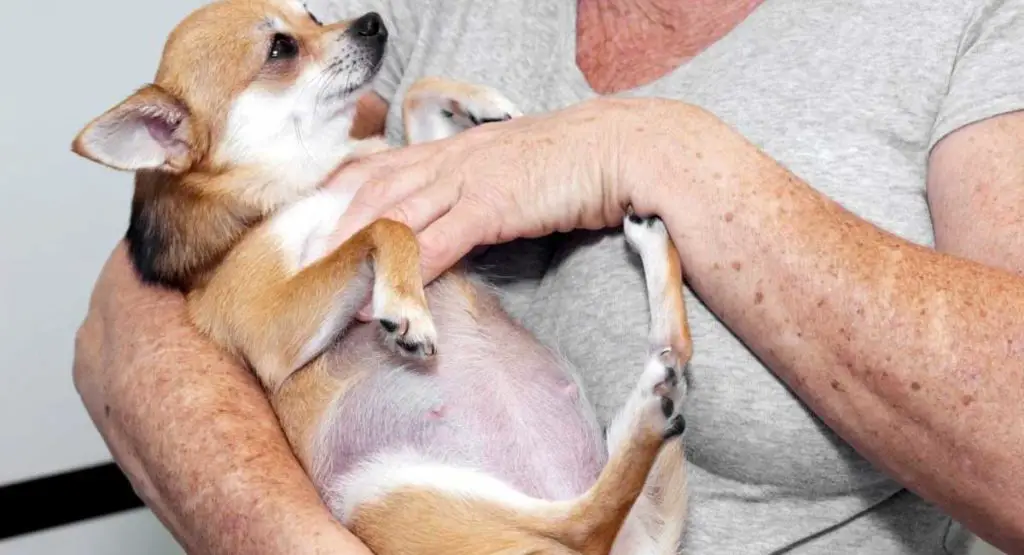A new litter of puppies is always a reason for joy, but the pregnancy can be stressful for both the dog and the owner. Things are even more complicated in first pregnancies, which are particularly confusing.
It’s important to know the difference between signs of normal pregnancy and a problematic one. The earlier you spot and remedy a complication, the better the outcome will be.
Here’s all you need to know about dog pregnancy and how to take care of a pregnant dog.
Canine Pregnancy Symptoms
Certain changes in a dog’s appearance and behavior can be signs that new puppies are on the way. Watching for these signs helps us notice Fluffy’s pregnancy before diagnostic testing.
Here are some of the symptoms that may indicate your pooch is pregnant:
- Your dog eats more than usual and weight gain is evident.
- Your pet’s belly and nipples become larger.
- While easily irritated at times, the pregnant pooch is generally more affectionate.
- Your dog gets exhausted fast.
- A temporary drop in appetite, decreased food intake, and vomiting may occur within the first couple of weeks of pregnancy.
These signs are fairly reliable, but they’re not always present. Some illnesses can produce similar symptoms. For those who believe their pet is pregnant, it would probably be best to take the animal to the vet.
Diagnostic Testing: What to Expect at the Vet’s Office
Since there are no pregnancy test kits for dogs that we can buy in a pharmacy, and early signs of pregnancy can also indicate something else, diagnostic testing is the only way to be sure whether Fido is really pregnant.

There are four kinds of tests that the veterinarian can perform:
- Abdominal palpation allows the vet to notice the presence of unborn puppies. Dog owners (unless he or she is a veterinarian) should never try to perform palpation; doing so risks injuring the puppies. This kind of testing can be performed after the fourth week of gestation.
- A blood test can be done between the 25th and 30th day of gestation. Pregnant bitches produce a hormone called relaxin. The presence of this hormone in the animal’s blood is a reliable sign of pregnancy.
- Ultrasound can be performed during the same period and a couple of days later. In addition to confirming the dog’s pregnancy, an ultrasound can give additional information, such as the number of the pups and their condition.
- An X-ray can provide the same information, but only in late pregnancy (starting from 55 or more days of gestation). By the time an x-ray can be performed, most owners already know that their pooch is expecting a litter.
All of these diagnostic tests are accurate and doing one of them is enough.
How Long Does a Dog Pregnancy Last?
Most dog pregnancies last for about two months. To be precise, typical gestation time is between 62 and 64 days. However, it’s nearly impossible to predict the exact time of delivery. Even if we know the date of breeding, we don’t knowthe time of conception.
The length of dog pregnancy also depends on the breed and the litter sizes (the number of the puppies). The development of cubs speeds up near the end of the second month of gestation.
How to Take Care of a Pregnant Dog: Check List
Once the pregnancy has been confirmed, it’s time to lean in and get devoted to your pet’s well-being more than ever before. A healthy expectant mother is more likely to have healthy puppies, so it’s crucial to pay special attention to adequate nutrition and activities. Also, keep an eye on her and watch for any signs of illness.
Proper Diet
Adequate amounts of high-quality food are essential during this exciting time. During the first month, a healthy dog of normal weight should eat the same amounts of food as before gestation or slightly more. During the second month, it’s advisable to gradually increase the daily amount until meals are up to 50% larger than before the pregnancy.
Remember: a pregnant dog might be prone to overeating, so it’s important to keep the portions small and feed the dog more frequently.
Moderate Activity
At the earliest stage of pregnancy, energetic exercise might result in embryo implantation failure. It’s probably a wise choice to let the dog rest for about two weeks. After that, it’s safe to let her perform moderate exercises until her belly grows. Near the end of the pregnancy, the only permitted exercise is taking a slow walk.
Checkups
Checkups are important before the breeding and during pregnancy. Ideally, vaccinations have already been completed. In case a dosage is missing, the safest way to solve the dilemma is to speak to the veterinarian.
Internal parasites can be a serious threat for the entire litter. That’s why the vet might propose a fecal exam. If it turns out that worms – such as hookworms and roundworms – have infested your dog, it’s generally safe to use a special sort of de-wormer after the 40th day of pregnancy. Fenbendazole is the only de-wormer that’s recommended for pregnant dogs. The treatment should be repeated about two weeks after whelping.
Regular checkups are one of the easiest ways to make sure that your dog will remain healthy.
Loving Support
Dogs are our special friends, and pregnant dogs need us to show our affection more than usual. Frequent cuddling and making sure she’s comfortable will help the pooch feel more relaxed.
How to Tell if Whelping is Near
Signs of labor are obvious. Your dog’s breasts and nipples should be much larger than usual. It’s even possible to notice small drops of milk.
Near the end of pregnancy, the dog’s abdomen is usually so large that it sways as she walks. In the final days, if you touch and cuddle your dog’s abdomen, you might be able to feel the puppies as they move around.
How to Prepare for Puppy Birthing
Whelping boxes provide a warm, safe, and clean place for the expectant mother and her puppies. Setting up a whelping box is recommended weeks before the due date so that the dog will have enough time to get accustomed to it.
The most important thing to ensure is that the mother can easily get in and out of the box, while the pups remain safe inside it, without any chance of them getting out. The next key thing is to introduce the box to the dog as soon as possible – ideally, before she comes up with the clever plan of delivering her puppies in your closet.
A whelping box can be bought or made, and a children’s plastic bath can make a good alternative. Place it in a quiet corner in your home, where your dog will have much-needed privacy. At the same time, you should be able to have quick and easy access to this area, in case anything goes wrong.
If you’re not sure what to do during the delivery and how to be helpful, talk to the veterinarian upfront. If there’s anyone else who would be able to help, it’s a good idea to have more people ready to jump in.
Whelping Supply: the Essentials
In addition to a whelping box, there are a few other things that you need to have ready before the delivery.
- A ton of newspapers and a couple of large garbage bags – the whelping box should be covered with newspaper, which should be removed after whelping is complete.
- Non-skid bath mats should replace the newspaper and serve for bedding.
- Clean and dry towels and paper towels for puppy cleaning.
- Sterilized scissors, unwaxed dental floss, and iodine – use the dental floss to tie off the umbilical cords, and the scissors to cut them; then clean the puppies’ bellies with iodine.
- A heat lamp or a hot water bottle to warm the puppies – check to make sure that none of these is super hot.
- A high-precision baby scale.
- Phone numbers of your veterinarian and an emergency clinic.
Whelping
Nesting and abstaining from food are sure signs that the delivery date is just around the corner. When whelping begins, the mother normally tears off the placental membrane covering the pups, and cuts the umbilical cord. In case she fails to do so, the owner must do that. Pups can survive within the membrane for more than a couple of minutes.
The mother will probably get thirsty and urinate often. So she’ll need enough fresh water and some extra towels. If she needs to get outside, make sure to keep the puppies warm.
Within a few hours, the mother should be nursing her pups.
If anything goes wrong, call the veterinarian without delay.
Final Word
Pregnancy is a challenging phase in the life of a dog and her owners. It can be excessively stressful if the owner is not properly informed and prepared. So read up, stock up, and be ready!
We hope we answered your questions about how to take care of a pregnant dog, and helped you get ready for some furry bundles of joy. If you have additional questions, check out ourother articles. In case an online resource isn’t sufficient, and you’re worried about your dog’s health, we encourage you to call a veterinarian without hesitation.






